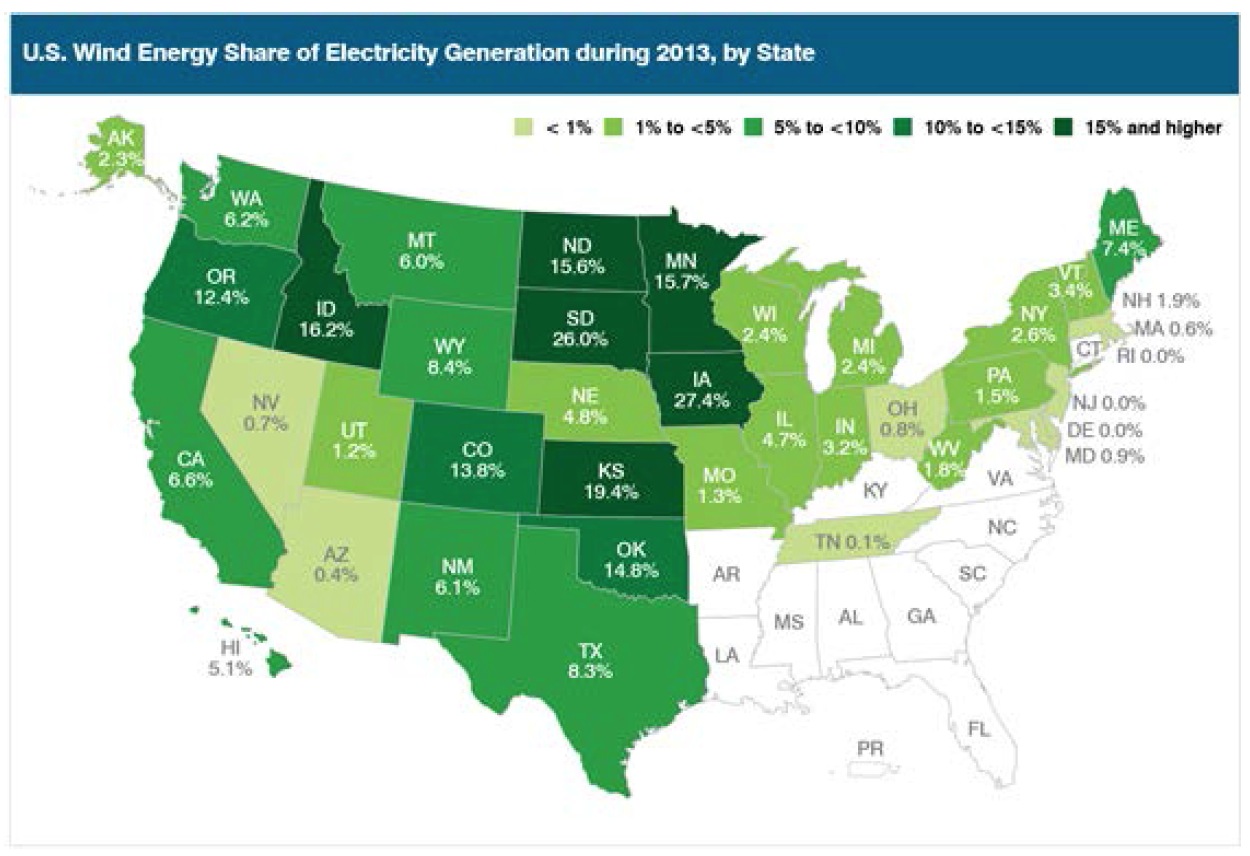AMERICAN WIND ENERGY ASSOCIATION
Executive Summary
Some of the most common questions about wind energy focus on how wind can be reliably integrated into the power system. A key source of confusion is that, contrary to most people’s intuitive experience that winds are variable and electricity demand and supply is stable, the opposite is actually true at the grid operator scale. The following report answers 15 of the most frequently asked questions with lessons learned from grid operators’ experiences reliably integrating large amounts of wind. Concise answers to these questions are provided here in the executive summary, while citations and explanations of the supporting data and analysis for those answers can be found in the relevant sections of the full report.
1. How much wind energy is on the power system now?
U.S. wind energy provides enough electricity to power the equivalent of over 18 million homes. Iowa and South Dakota reliably produced more than 25% of their electricity from wind last year, with a total of nine states above 12% and 17 states at more than 5%. At times, wind has supplied more than 60% of the electricity on the main utility system in Colorado, and nearly 40% of the main Texas power system.
2. How do grid operators accommodate such large amounts of wind energy?
Variability and uncertainty are nothing new for grid operators, as they have always dealt with large and unexpected fluctuations in electricity supply and demand by changing the output of power plants. Most changes in wind output are canceled out by other offsetting changes in electricity supply and demand, and any remaining variability is accommodated using the same flexible reserves that grid operators have always used. In fact, because changes in wind output occur gradually and can be forecast, they are less costly for grid operators to accommodate than the abrupt failures of large conventional power plants.
3. How much does it cost to integrate wind?
Grid operator data show that the cost of the incremental flexible reserves needed to accommodate wind amount to pennies on a typical electric bill. In fact, the cost of accommodating the unexpected failures of large conventional power plants is far higher.
4. How much more wind energy can we reliably integrate?
While U.S. and European grid operators have already reliably integrated large amounts of wind energy, studies indicate that we can go far higher. Studies examining obtaining 40% or more of our electricity from wind have found no major obstacles to doing so. Ten years ago some utilities and grid operators were concerned about reaching 5% wind; they now have a lot more experience to draw from, and over the next ten years, they will surely learn more and be able to continue increasing reliable penetration.
5. Don’t grid operators need to add backup to integrate wind?
No. One of main reasons why an integrated power system was first built more than 100 years ago was so that all power plants could back up all other power plants. Because most sources of variability cancel each other out, having a dedicated backup source for each would be highly inefficient and counterproductive.
6. What happens when the wind doesn’t blow?
Other plants provide energy at those times, in the same way that all power plants back up all other power plants. Portfolio diversity is the key, as no resource is available 100% of the time. All power plants have reduced output at times, and grid operators plan for wind’s contribution using the same tools they use to evaluate the contributions of other resources. Adding wind power never increases the need for power plants, but rather reduces it. During a number of events wind has demonstrated its contribution to a more reliable and diverse energy portfolio by stepping in when other resources failed unexpectedly.
7. Don’t we need baseload power?
Instead of using the term “baseload,” it is more productive to talk about the three main services the grid needs to operate reliably: energy, capacity, and flexibility. Energy is the production of electricity, capacity is the ability to produce power during periods of high demand, and flexibility is the ability to change output to keep supply and demand in balance. Cost-effectively obtaining all three services requires a division of labor among a diverse mix of energy sources, as no resource excels at providing all three. For example, baseload resources typically do not provide flexibility, and there can be lower-cost ways of obtaining the energy and capacity provided by baseload. Wind energy primarily adds value to an energy portfolio as a low-cost and non-polluting source of energy, though it also provides some capacity and can provide flexibility when it is economic to do so.
8. What about the reliability services provided by conventional generation?
As wind energy has grown to provide a larger share of our electricity mix, wind turbine technology has matured so that modern wind plants are able to provide the same grid reliability services as conventional generators, including voltage and reactive power control, frequency and inertial response, active power control, and voltage and frequency ride-through. In some cases the reliability services provided by wind exceed those of conventional generators, while in other cases conventional generators can provide those services more economically than wind generators, but wind generators can provide those services if it becomes economic to do so.
About the American Wind Energy Association
www.awea.org
AWEA is a national trade association representing wind power project developers, equipment suppliers, services providers, parts manufacturers, utilities, researchers, and others involved in the wind industry – one of the world’s fastest growing energy industries. In addition, AWEA represents hundreds of wind energy advocates from around the world.







 RSS Feed
RSS Feed
“because changes in wind output occur gradually and can be forecast, they are less costly for grid operators to accommodate than the abrupt failures of large conventional power plants.”
This is one of the most cogent arguments I’ve heard for wind. In fact, without straining, I could apply something similar to solar.